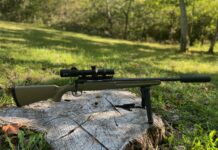I’m not saying that my previous feel for the auto industry gestalt (at The Truth About Cars) led to some excellent investments like, say, shorting GM stock. But if I had assembled a small coterie of automotive-minded investors, I reckon we would have done extremely well. Perhaps even well enough for me to tell my overlords to put it where the sun didn’t shine, and start up a new website. That’s the theory. In practice, I’m hoping that The Truth About Guns will one day earn that same level of interest from the finance folks. Rest assured, TTAG will highlight the biz side of the biz—despite the arms industry’s reticence to give [supposedly] damning data to their enemies. So . . . Alexis Evidente of gurufocus.com reckons Ruger stock is not for you. True?
RGR [Sturm, Ruger & Company] as a company feels very much like an their SR9c model – smooth, compact and explosive with rising revenue, profit margins and free cash flow. When combined with a ultra low EV/EBITDA multiple I was ready to squeeze the trigger and issue a trade alert for CR Investor members.
[Note: EV = Equity Value: the market capitalization of a firm’s equity plus the market value of the firm’s debt. EBIDTA = Earnings Before Interest, Depreciation, Taxes and Amortization]
As much as I wanted to pull the trigger and issue a Buy rating, I knew I had to dig deeper and gain a better understanding of the company.
The nice revenue growth in 2008 & 2009… Chalk that up to President Obama and the public’s perceived fear of a gun ban. A key metric in determining demand for new guns is to track monthly background checks, and we have found that the number of new background checks per month is well off the highs of 2009. To further compound the problem, RGR has no government or military contracts which are a good secure source of steady revenue for many gun manufacturers. Therefore, RGR is set to rely on civilian purchases and in our view peak buying has already occurred.
The Obama sales surge fired-up immediately prior to his election in November 2008. As has been widely reported, rifles—both traditional and “assault”—accounted for most of the growth. Ruger rode the wave. According to Ruger’s 2009 10-k SEC filing, rifles racked up some $102.2 million worth of rifle sales in 2009, up from $69.4 million and $64.9 million in 2008 and 2007 respectively.
And no wonder. Ruger makes some lovely “tactical” weapons: the M77 Hawkeye and the Mini-14 spring to mind. Ruger also makes an AR-15 clone: the SR-556. It’s a pricey piece ($2995 stock) that arrived late to the party (May ’09). And while the promo video aims the gun at military and LE officials, as Evidente points out, non-civilian sales suck.
But the numbers don’t lie: the SR-556 and Ruger’s SR-22 (a clone of a clone) must have accounted for their fair share of that $32.8 million ’09 bump. Pistols are doing right well, too, generating revenues of $87.5 million in ’09 (up from $52.5 million, and $33.4 million for 2008 and 2007). Revolvers are rocking, albeit gently, adding $58.3 million to Ruger’s bottom line (up from ’08’s $41.0 million and ’07’s $35.6 million).
The only cloud on Ruger’s product-related horizon: shotgun sales. They’re plummeting: $1.2 million, $1.5 million, and $3.8 million of revenues for the years 2009, 2008 and 2007, respectively. The Red and Gold Label guns are such a drug on the market it makes you wonder: why bother? We’ll get to that in a minute.
Meanwhile, check out these results for 2009:
- Our firearms sales grew from $174 million in 2008 to $267 million in 2009 on the strength of new product shipments and overall robust firearms demand, particularly in the first half of the year.
- Estimated sell-through of our products from independent distributors to retail in 2009 increased by approximately 40% from 2008, and 86% from 2007. This annual growth substantially exceeds the 10% and 25% growth in National Instant Criminal Background Check System (NICS) background checks over the same periods. Comparisons of NICS checks from period to period are often used as a proxy for consumer demand for firearms.
- In response to the significant increase in demand in 2009, the Company increased production in 2009 by 56% from 2008, and 101% from 2007. This increased production was facilitated by the Company’s implementation of lean manufacturing, an ongoing process that started in 2006.
- Cash generated from operations during 2009 was $46.7 million. At December 31, 2009, our cash, cash equivalents and short-term investments totaled $55.7 million. Our pre-LIFO working capital of $104.0 million, less the LIFO reserve of $38.7 million, resulted in working capital of $65.3 million and a current ratio of 3.0 to 1. The Company has no debt.
- In 2009, capital expenditures totaled $13.8 million. We expect to invest approximately $10 to $15 million for capital expenditures during 2010.
- In 2009, we paid dividends totaling $5.8 million to our shareholders.
- At December 31, 2009, $4.7 million remained authorized for share repurchases. On February 5, 2010, we announced that our Board of Directors expanded this repurchase program from $4.7 million to $10 million.
No debt? Growing sales? Working capital? It’s hard to understand why the market—and Evidente—are so down on Ruger.
Another negative about RGR is the declining economics of the industry itself. Gun regulation is becoming increasing more stringent which makes continued success difficult. In essence, we can expect more adverse laws to gun ownership. Also, RGR depends on new gun sales and has to compete against itself when a potential gun owner weighs the pros and cons of a buying a new or a used Ruger firearm.
Stuff and nonsense. Gun sales may not be booming, but that’s only in relation to the pre-Obama surge. Last year, firearms sales rose by at least a million units; that’s hardly what I’d call cratering. Our industry sources tell us that AR-style gun sales are still healthy. They may even have experienced a slight rise after Obamacare made it through the democratic process.
At the same time, states are busy switching to “shall issue” laws, making it easier (if no less bureaucratically cumbersome) for citizens to purchase and carry a firearm. After taking down D.C’s handgun ban, The U.S. Supreme Court looks set to strike down other handgun bans and Second Amendment restrictions. The easier it is to buy, own and carry a firearm, the more they’ll sell. Period.
While that “new vs. used” debate certainly applies to automobiles and weapons at the $5k-and-up level, it’s simply not a decisive factor in the lower end of the handgun market. In fact there’s a school of thought that says the availability of a good used weapon leads buyers into that brand’s “family.” Once satisfied, they’re more likely to trade up to a new gun from the same company than switch brands.
More importantly, the President is eying-up the extremely restrictive U.N. Small Arms Treaty for 2012. Even a head feint in that direction will trigger a HUGE wave of pre-ban assault rifle, handgun and ammo buying. And the rest (it’s a wide-ranging document). If the U.S. Senate looks likely to ratify the accord, look for guns and ammo shortages.
Taken as a whole, the legislative and economic (yes, economic) climate looks good for Ruger—-provided we remain wary of two main dangers.
First, SADIF-Investment Analytics says Ruger’s got inefficient management. I can’t afford the big buck to find out exactly what they mean. Maybe SADIF was put off by the fact that Ruger CEO Michael O. Fifer took home $1.53 million last year. To the victor belongs the spoils. And I wouldn’t expect a Harvard MBA and former Navy submariner to run anything but a tight ship. Still, maybe they know something I don’t (perish the thought).
Second, branding. In 2005, as the new guard took over, Ruger introduced 42 new products. The feat won them the Shooting Industry Academy of Excellence Manufacturer of the Year Award. But the huge number of brand extensions has diluted the Ruger brand. In fact, what is a Ruger? It’s a pistol, a hunting gun, an assault rifle and a shotgun. It’s cheap AND its expensive. It’s made by a small company, but it’s products are not exclusive. It’s American-made, but is that really such a big deal?
When there was a Ruger at the head of Ruger, the company had a family feel—which wasn’t always a good thing. [See: the “Ruger Letter”]. But it was a thing. Now, what’s Ruger’s thing? The company’s strap-line says “Rugged, reliable firearms.” Is that a defensible unique selling point? These days, aren’t all firearms rugged and reliable?
Again, shotguns are Ruger’s weakest link. Do they cut bait and fish, putting those resources into other products, or cling to the idea that they’re a full-line gunmaker and do something to make a Ruger shotgun unique and throw marketing dollars its way? Do they have the will to win everywhere all the time or the common sense to focus their forces where they can make maximum gains?
In any case, Ruger knows it has to spent money to move its products upmarket—or face killer competition from larger and more efficient (read: foreign) manufacturers. “A shift in product mix toward firearms with higher unit sales prices, including some new products, resulted in the relatively lower percentage increase in unit shipments compared to the percentage increase in sales,” the 10-K soothes. Yes, well, over the last three years, Ruger’s average unit’s sale price has been $288, $278, $299. That’s not a lot.
So here’s your TTAG summary.
America’s bread-and-butter firearms industry is chundling along nicely. Ruger’s handgun business is rock solid, with newer models finding favor with mainstream buyers. Rifles are rockin’. Despite the fact that the company has yet to find and promote a single, compelling raison d’etre, Ruger’s short to medium term future looks excellent. The stock is a solid if unspectacular buy—that could go ballistic if Ruger lowers the SR-556’s price in time for the next assault rifle surge.
Fair enough?




"close range social work?"
Comments are closed.